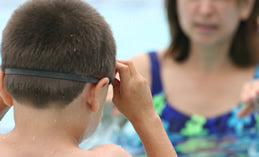How to Choose a Pull Buoy
 Pull buoys are buoyant pieces of foam held between the thighs while swimming. Pull buoys keep swimmers' legs and hips at the surface of the water, allowing swimmers to stop kicking and concentrate exclusively on pulling and body rotation technique. Since pull buoys isolate the upper body, they also help swimmers increase arm strength.
Pull buoys are buoyant pieces of foam held between the thighs while swimming. Pull buoys keep swimmers' legs and hips at the surface of the water, allowing swimmers to stop kicking and concentrate exclusively on pulling and body rotation technique. Since pull buoys isolate the upper body, they also help swimmers increase arm strength.
There isn't much variety in the world of pull buoys, but it is important to find one that fits. The right shape and buoyancy can make quite a bit of difference in the value pull buoys provide, and this guide outlines the various benefits of different pull buoy styles.
Pull Buoy Design & Shape
Pull buoys come in two main silhouettes: One-piece and two-piece. One-piece pull buoys are sculpted pieces of foam, with rounded ends and a narrow middle section. They are usually roughly the shape of an "8." Some are symmetrical, while others have one narrow end and one wide end for a slightly more ergonomic fit. Placing the wider end under the thighs makes it easier to grip the pull buoy for long periods of time. They are made of soft foam that can withstand many hours of exposure to chlorine and sunlight.
Two-piece pull buoys consist of two separate foam cylinders connected by nylon straps. Two-piece pull buoys are a more old-fashioned design, but they do allow swimmers to adjust the distance between the cylinders for a customized fit. These foam cylinders also tend to get a bit abrasive as the pull buoys age, unlike one-piece pull buoys.
Pull Buoy Size & Buoyancy
Some people require more buoyant pull buoys than others. Anyone with large legs, heavily-muscled legs, or legs that have a tendency to sink should look for a larger pull buoy. To that end, there is some variety when it comes to choosing the size — and therefore buoyancy — of a pull buoy. Buoys with thicker, wider, and more generous ends keep even the heaviest legs at the surface of the water. Too-small pull buoys won’t keep the legs high enough, and can reinforce an incorrect body position.
Children and petite people should get pull buoys in smaller sizes; either ones designed specifically for juniors, or merely in a smaller size. Although smaller people can still use large pull buoys, they won't be as balanced in the water and the large pull buoy can prevent some of their body's rotation as they swim.
Other Pulling Options
Select brands manufacture a combination pull buoy-kickboard, usually called "pull-kicks." These are designed to function as both pull buoy and kickboard, and can help cut down on the amount of swim gear swimmers cart to and from the pool. There are also buoy systems that consist of individual bands that wrap around the thighs and help legs float. This removes the need to "grip" the pull buoy to hold it in place.
Nearly every swimmer can benefit from pulling practice, both for the strength training and the chance to concentrate on technique. Finding the right pull buoy makes pulling more comfortable, more effective, and more fun!

